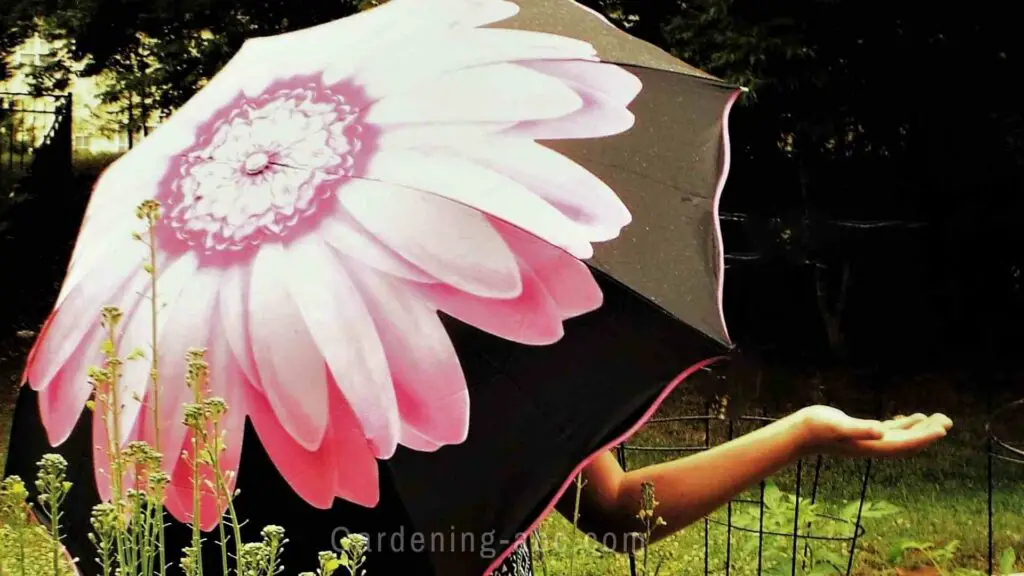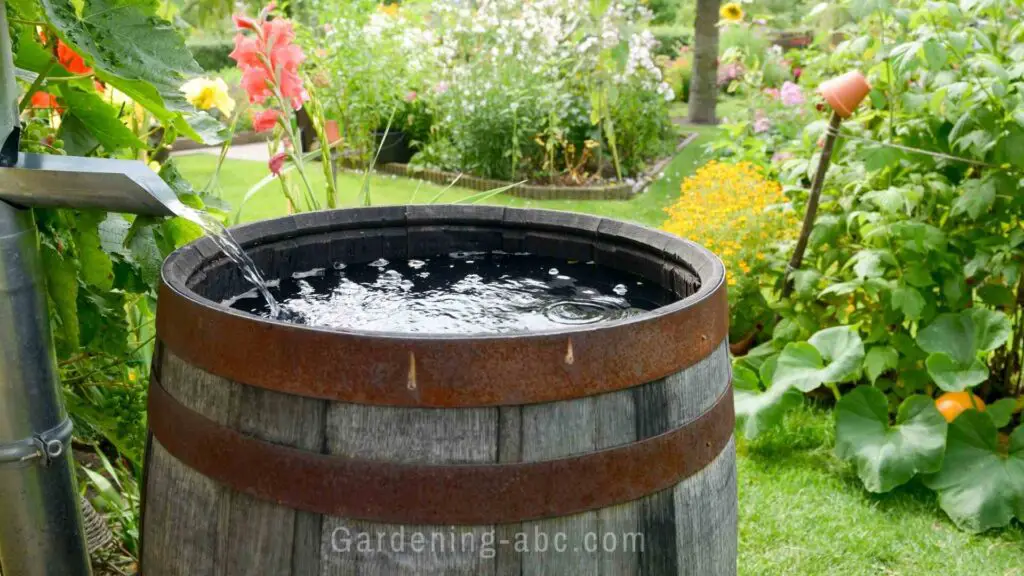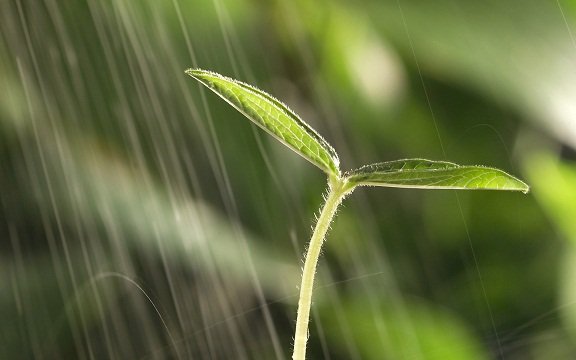We use affiliate links to run our site. When you buy through links on our site, we may earn an affiliate commission, without any added cost to you. Learn more
Did you know you can garden in the rain? With a little bit of preparation, in addition to the right gardening tools, you can still enjoy a day of digging and planting even if it’s pouring.
Monsoons can be problematic for gardeners in a variety of ways. It often leads to the waterlogged, muddy ground, which makes it incredibly hard to walk through and difficult to carry equipment.
Also, when the water falls directly on plants, leaves and flowers get saturated quickly and can suffer from rot or fungal infections.
But don’t despair; there are ways around the problems and you don’t need to lose your enthusiasm during this depressing time of year!
Rainy days don’t have to be a complete waste, we can still go outside and do our gardening tasks. I will have a look at some of my favorite things to do on rainy days and how you can enjoy your garden when the weather is against you.
Will Too Much Rain Hurt My Garden?
The rain brings a lot of benefits to the garden: It cools things down and provides a nice drink for thirsty soil. It also helps wash away any airborne particles that might be contaminating your veggie harvest, like dust or pollen.
As much as we don’t like getting wet, a light rain can actually be good for us—it helps us cool off and has been known to relieve stress. So while it might not always feel like it, when it rains, it pours with opportunity!
Yes, too much rain will hurt your garden! While too little rainfall can cause problems for plants and gardens, too much can really bring down your entire crop and ruin any chances of an abundant harvest.
Useful Kit To Cope With The Wet Weather
Even if it is raining, you can still enjoy your garden and get things done. There are many useful kits that will help you to cope with the rain such as:
Greenhouse:
Your plants need protection from cold winds or heavy rain, so if you don’t already have one consider building a greenhouse. It’s very easy to do, too! All you really need is some wood, plastic sheeting, and some nails.
Decide where to put it so that your plants have enough sunlight exposure as well as protection from the elements. There are many types of greenhouses available for purchase as well, ranging from small hobby greenhouses up to large ones able to fit a family!
A greenhouse like this can also collect and drain rainwater easily.
Garden Track:
If you’ve ever seen those running tracks that criss-cross around a park or school, you might want to invest in one for your garden.
You can easily make a garden track with bricks or paving stones in order to avoid getting mud on your shoes and clothes when going around your plants and flowers. You can also place some stepping stones in your garden so that you won’t step into the wet soil.
Garden Shade:
Sheds are incredibly versatile – they’re perfect for storing pots, tools, and equipment but they’re also ideal for keeping plants and soil dry so they can be used again later in the year.
Sheds are also ideal if you’re short on space in your house. Just pop all your gardening stuff in the shed so it’s not cluttering up valuable space inside.
Always look for water-resistant sheds like these that won’t rust or rot in rain and will last very long.
Use Grow Bags or Containers:
Grow bags or containers are great for keeping plants safe from excessive rain, especially if you have raised beds in your garden for growing veggies that may well be exposed if left uncovered during heavy rains. If there’s no space in your garden.
How to grow tomatoes in grow bags.
How Can You Prepare For Gardening in The Rain?
When the weather forecast predicts rain, there is a lot of preparation that needs to be done in the garden. Be ready for the monsoon and safeguard your plants and flowers from it. Here are some of the things you should do before the hailstorm hits your garden.

Remove Damaged Shoots And Limbs
Remove any damaged shoots and limbs of your plants so that it doesn’t infect other parts of the plant, and reduce the risk of snapping and tangling.
Support Taller Plants
Rain sometimes comes with strong winds. So you need to support your taller plants in the garden so that they don’t get snapped off. Simple garden stakes or cages are great for supporting smaller plants like tomatoes.
Make Sure There Is Adequate Drainage
The first thing you need to do is make sure there is adequate drainage in your garden. Your garden should have a proper runoff that slopes away from that garden and, it should not be blocked by anything.
While It’s Raining
Rainy days don’t mean that you have to stay inside. In fact, it’s even better for your garden if you get outside. Here are some things you can do in your garden while it’s still raining:
Collect Rainwater

This is one of the most important things you can do if you’re a keen gardener. Rainwater is free of chemicals and pollutants and is perfect for watering your plants and other garden needs
Put down a large plastic sheet and direct any gutters onto it. This will fill your containers. You can use this later for houseplants, seedlings, and window boxes.
You can also make a simple rainwater harvesting system that will help you collect and store the water.
Inspect Your Garden:
Identify areas that need attention and take care of them, whether it’s adding mulch, weeding, or cutting back perennials.
Check out for signs of soil erosion. Is every plant in your garden getting rainwater or some of them have been sheltered?
You might also want to consider adding new plants around your yard so they’re growing before winter sets in.
Cover the Most Delicate Plants:
Cover your most delicate and fragile plants using a waterproof covering such as tarpaulin or plastic covers during a heavy downpour. This will protect your fragile plants from getting damaged by the heavy rain.
It is also an opportunity for your indoor plants to get some rainwater so bring them out for a while.
Tidy Up Your Garden:
Put on some waterproofs, rubber gloves, and a hat. Then get out there with your secateurs and tidy up your garden. Collect dead leaves, weeds, and twigs that have blown into the borders or around trees into the wheelbarrow for burning or composting.
Turn your compost:
Turning over your compost pile when it’s wet won’t do it any harm. In fact, you’ll speed up the process and give yourself ready-made soil in no time at all!
Mixing your pile while it’s still raining make sure all the layers of that compost heap will get the moisture without which the decomposition won’t work.
After the rain:
Follow these simple steps to keep your garden looking fresh even after the rain is over:
Avoid Soil Compaction:
Keep off the soil as much as you can so you don’t compact it. Wet soil compacts easily, especially if it has a high clay content. Once it dries out it can be as hard as concrete.
Remove Weeds:
Weeding is a necessary part of any garden. it will be easier to weed on a rainy day because the soil is evenly moist and soft. This will make it easier for you to pull out any unwanted plants that are growing in your garden.
Watch For Slugs and Snails:
Slugs and snails often take shelter from the rain under leaves, so it’s important to check your plants for them once it stops drizzling. You’ll need to act fast because they tend to move fast too, especially when they’re hungry.
A quick squish or spray with a homemade mixture of salt and water will take care of them.
Install Stakes:
Once the rain has stopped, use twine or rope to tie down any plants that look like they might blow away in the next storm.
Not only will this keep your garden looking good, but it can be a lifesaver for any transplant that might have been blown over during the last windstorm.
Check Your Potted Plants:
While the sun is shining and the rain is over, check your pots and planters. Some people like to move them under cover during a rainstorm.
Lift up the ones that are sitting directly on the ground and look underneath at the drainage holes. Check them to make sure they’re clear of debris and foliage; also look for signs of rotting that might have started in your pots before you covered them up.
If you have vegetables growing, feed them; if you have herbs, pinch them back. Make sure everything is in order for when the sun shines again.
Check Your Vegetable Roots:
It’s also a good time to check your vegetable and herb roots to see how they’re doing in the ground. Cautiously pull up some of your kale and root vegetables to see how they’re doing before winter sets in.
Pulling some beets or carrots will give you an early start on the harvest next summer.
Harvest Lettuce:
It is the perfect time to harvest lettuce leaves(if you have any in the garden). They will taste better sweeter and softer after a rainfall.
How To Protect Plants In A Raised Bed:
If you’ve got a raised bed, cover it with a tarp or plastic sheeting. Make sure it’s well anchored at the bottom so that it doesn’t blow away in the wind.
A good rule of thumb is that the plastic should be at least 6 to 8 inches from the plants. Use stakes or weights to hold down the edges of the plastic.
Consider using raised beds if you have an area that is prone to flooding. You can also create a type of raised bed by piling up mulch instead of planting vegetable seeds directly into the ground.
If you don’t know how to set up a raised garden bed this post is for you. Here we discussed the setup process step-by-step.
Plants That Do Well In Damp, Wet Weather:
Some plants also do better if they’re kept consistently moist while others don’t.
Grow rainy plants that survive in damp weather. Wet weather is great for some plants and flowers.
Plants such as hostas, bamboo, hollyhock, and astilbe are often used in rain gardens because they need a lot of water. Perennial herbs such as mint also do well. Think about what you want to grow and then look for plants that fit the bill.
Set Up A Rain Garden:
Rain gardens can be beautiful additions to your landscape. A rain garden is simply a depression in your landscape where water collects and is allowed to sink into the soil rather than run off into storm drains.
The plants absorb the water, purify it and help prevent flooding in your neighborhood. Rain gardens are especially important if you live in an area with poor drainage or lots of impervious surfaces like concrete or paving stones that prevent water from sinking into the ground.
It is also a great way to attract wildlife to your garden, especially, if you have plants that are wildlife-friendly.
Learn how you can easily set up a rain garden in your backyard.
Dressing For The Wet Weather
Gardening “in the rain” is almost as great as it is on a sunny day, but there are a few things you can do to ensure that you stay comfortable and dry.
Go out with an umbrella:
Even if you’re working in containers on a patio, an umbrella can give you some extra protection from the rain. If you’re planning to work in the garden, though, it might not be enough.
Waterproof Gloves:
Wear waterproof gloves or use plastic bags over your hands when you’re gardening so that your skin isn’t exposed to wet or muddy conditions. This will keep your hands dry and comfortable even if the area is getting soaked.
RainBoots:
Rainboots are very important for gardeners. They keep your feet dry while allowing you the freedom to move around. They are made of rubber or another material that will not retain water.
They also have threaded bottoms so you can walk on slippery surfaces without falling.
Rainboots come in ankle-high, knee-high, and thigh-high styles and often have ventilation holes for cooling air circulation inside. Here is a cool one you can check.
In A Nutshell:
The following are some of the few points which we need to take into consideration for having an enjoyable gardening season in the monsoon:
- The first and foremost thing is that you have to make sure you have a proper drainage system. If water got stagnant it will make the plants rot.
- To prevent the risk of fertile topsoil erosion in the garden use perforated sheets. It will allow the rainwater to reach the plant as a sprinkler. So the plants do not get deprived of their natural nutrients available in the topsoil.
- Do your transplanting on cloudy days. This prevents a lot of transplant shock.
- If you are planting new saplings, plant only those plants that can adjust to the moisture of the monsoon season. The young plants in the garden and those plants which are too fragile should be sheltered adequately to save them from the deluge.
- Avoid chemical fertilizers as far as you can, instead try nature’s own compost. Earthworms are gardener’s friends. They not only aerate the soil by tunneling it down but also fertilize it.
- Avoid pesticides altogether. As it will get mixed, transferred with water, and will cause huge damage to the garden. Instead, try to use a biological controller such as Toads and Frogs. They are voracious insect eaters and can be a very good friend to the gardener.
- Mix a good proportion of soil and compost manure for new plants.
- It is the right time to try your hand at indoor gardening. Also, bring those plants outside so they can get the feel of the moisture in the air.
Conclusion:
So, you can see, rainy days are not a complete waste – there are plenty of things you can do outside in the garden. There’s no need to settle for an indoor lifestyle if the sun isn’t shining.
Gardening during monsoon is not always easy. But with a little bit of preparation and a few tools, it is just as fun as gardening on sunny days.
So next time you see those dark clouds on the horizon, don’t worry – there’s always something fun to be done in your garden, even if it’s raining!
Amazon and the Amazon logo are trademarks of Amazon.com, Inc, or its affiliates.


I havent any word to appreciate this post…..Really i am impressed from this post….the person who create this post it was a great human..thanks for shared this with us. ecosystem